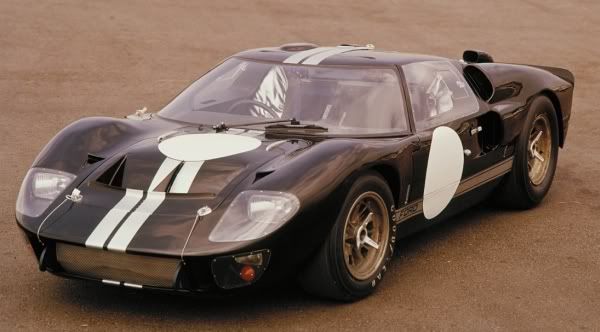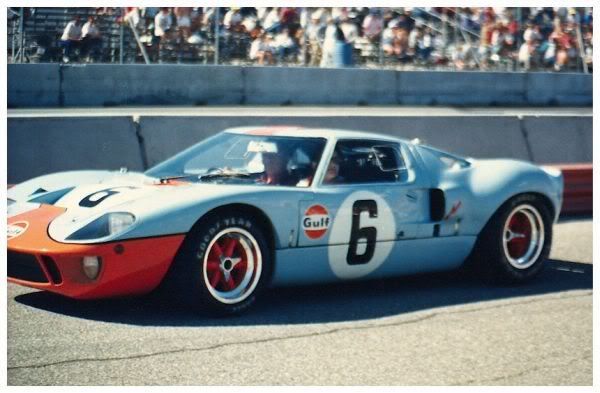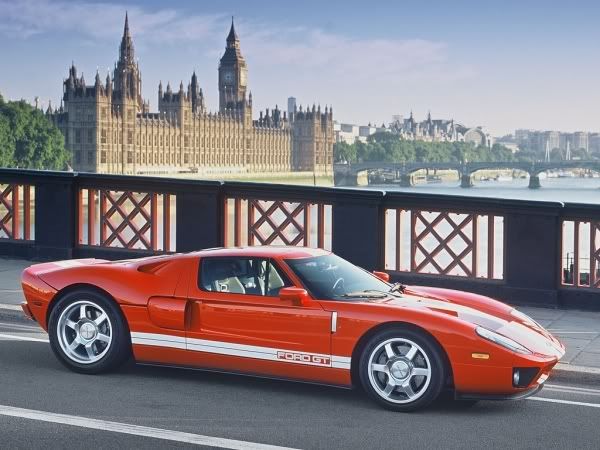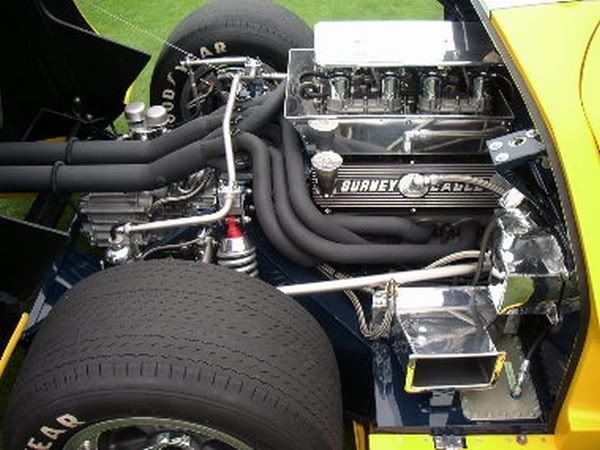Auto Erotica - The Legendary Ford GT40

Without going back too far into the vintage or pre-modern era, there are a few cars that certainly have earned the title "legendary" in the prototype road racing and GT world: the Jaguar "D" type of the late 1950's, the Porsche 917 of the early 1970's, and the featured car here today, the Ford GT40 of the mid to late 1960's. The history of these cars is quite detailed and complex, so I will only give a brief summary of the evolution of the car and encourage you, dear reader, to check-out the links provided for a complete history. Following my run-down of the car's history there are some photos as well as an in-car video ride!
Initially, the first generation cars, the MkI, were derived from the British Lola and used the aluminum Ford "Indy" DOHC 4 cam engine displacing 255 cu.in.(4.2L) as well as the venerable 289 small block. These cars, named finally "GT40" for being exactly 40" tall, were first debuted in 1963 and raced at the Nürburgring 1000 km race in 1964, but didn't fare too well as they were weak in suspension and low on torque, as well as having gearbox and transaxle problems. They also were the result of considerable controversy. Henry Ford II wanted to beat Ferrari at the prestigious 24 Hours of Le Mans so badly that he entered into serious and expensive negotiations to buy Ferrari.
In the spring of 1963, Ford reportedly received word through a European intermediary that Enzo Ferrari was interested in selling to Ford Motor Company. Ford reportedly spent several million dollars in an audit of Ferrari factory assets and in legal negotiations, only to have Ferrari unilaterally cut off talks at a late stage. Ferrari, many commentators have surmised, got right to the point of signing the deal and realized he simply could not let go of the entity that carried his name. Henry Ford II, enraged, directed his racing division to find a company that could build a Ferrari-beater on the world endurance-racing circuit.In 1966 MkII GT40s, now with the project under the direction of Carroll Shelby and fitted with the same big-block 427's(7L) that Shelby was using in his Cobras, finished Le Mans 1-2-3, in a controversial "team orders" debacle that saw the team of the two New Zealand drivers, Bruce McLaren and Chris Amon, taking first place.
...in the final few hours, the Ford GTs of New Zealanders Bruce McLaren and Chris Amon were running close behind the leading Ford GT driven by Ken Miles. Ford team officials faced a difficult choice. They could allow the drivers to settle the outcome by racing each other -- and risk one or both cars breaking down or crashing. They could dictate a finishing order to the drivers -- guaranteeing that one set of drivers would be extremely unhappy. Or they could arrange a tie, with the McLaren/Amon and Miles/Hulme cars crossing the line side-by-side. The team chose the last and informed McLaren and Miles of the decision just before the two got in their cars for the final stint. Then, not long before the finish, the Automobile Club de l'Ouest (ACO), organizers of the LeMans event, informed Ford that the geographical difference in starting positions would be taken into account at a close finish -- meaning that the McLaren/Amon vehicle, which had started perhaps 60 feet (18 m) behind the Hulme-Miles car, would have covered slightly more ground over the 24 hours and would therefore be the winner. Secondly, Ford officials admitted later, the company's contentious relationship with Miles, its top contract driver, placed executives in a difficult position. They could reward an outstanding driver who had been at times extremely difficult to work with, or they could decide in favour of drivers (McLaren/Amon) with less commitment to the Ford program but who had been easier to deal with. Ford stuck with the orchestrated photo finish but Miles, deeply bitter over this decision after his dedication to the program, issued his own protest by suddenly slowing just yards from the finish and letting McLaren across the line first.The MkII also won that year at the 24 Hours of Daytona and the 12 Hours of Sebring.
For 1967 Ford took the design and build back to America with Shelby still in charge of production and Kar Kraft in Detroit doing the design work which included wind tunnel testing and aerospace-derived components and materials. The car was quite different from the MkII and became the MKIV using what became known as the "J chassis," and it was chassis #J6 driven by A.J. Foyt and Dan Gurney that won Le Mans that year averaging 135mph for the 24 hours. The car was raced only one other time that year in Daytona and won there, too. At Le Mans on the Mulsanne Straight, which was then 3 miles long, this car achieved a top speed of 220 mph.
The MkIII was a production car for the street; only 7 were built.
In 1968 rules changes in engine displacement limited prototypes to 3.0L, but allowed 5.0L in cars of which at least 50 were made for homologation into the GT class. The revamped MkI with a 5.0L(302cu.in) engine making 475hp won that year as well as in 1969 in a nail-biting finish where the GT40 driven by Jack Ickx (shown below) edged-out a Porsche 908 by mere meters, the closest finish to date in Le Mans history.

By 1970 the GT40 was obsolete, and Porsche's 917 with its 4.5L, flat-12 cylinder engine developing well over 500hp (later stretched to 4.9L and making nearly 600hp) had all the previous year's bugs worked out, making it the dominant car for the next few years.
Go here, here, and here for everything you ever wanted to know about this remarkable car, as well as some more great photos.

The modern Ford GT production car, with its obviously inspired heritage.

A GT40 competing at a vintage road race at Watkins Glen, NY.
Take a ride in a GT40!
Did you notice that tall first gear? Definitely not set-up for drag racing! You may have also noticed that the car makes a strange, high-pitched (for a V8) howl starting in the mid-range as it comes up on the cam, giving it quite an exotic (and beautiful!) sound. That is due to what is known as a "180 degree" exhaust configuration. If you look closely at the photo below, you'll notice that the two primary header pipes in the middle of each cylinder bank (#4 & #6 on one side, #3 & #5 on the other) cross over to the opposite collector. Based on firing order, this configuration avoids consecutive firing cylinders "stacking" into the same collector which improves the scavenging effect of a tuned exhaust and also changes the harmonic resonance of the sound and pressure waves. It can be worth 25hp or more and an even more significant increase in mid-range torque and an overall flatter torque curve, thus improving drive out of the corners and overall acceleration. This car is fitted with the small-block engine (either the 302 or the 289) and has 4 Webber 2-barrel carbs feeding the Gurney-Westlake aluminum heads. The 180 degree exhaust was also used in the big-block cars (although with larger diameter primaries and collectors). A mid-engine car like the GT40 lends itself to easily incorporating this exhaust into the design, but, because of firewall constraints, it's a bit more dificult in a front engine car. (Some NASCAR guys were doing it in the mid and late 70's, and I have seen it in one Camaro that was competing in SCCA GT2 racing back in the late 80's at Moroso Motorsports Park in West Palm Beach, FL. Nobody else had it, and that guy left them all in the dust out of the corners and down the straights.)

Labels: Auto Erotica









3 Comments:
My knowledge of automobile mechanics never was that great--in fact, I got kicked out my high school auto mechanics class!
It's getting harder and harder to find roads to open up a hi-po car.
Pisses me off.
Now, Montana................
Vilmar
OCM, I try not to get too technical, but sometimes I just can't help myself!
Vilmar, ever considered going to a "track day"? I'm sure that the local Corvette Club organizes days where they rent a road course for its members to get their ya-ya's out in a controlled environment. It's worth looking into!
Post a Comment
<< Home